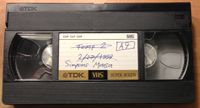VHS
(added info about color-under) |
Dan Tobias (Talk | contribs) (→Other links and resources) |
||
| (19 intermediate revisions by 3 users not shown) | |||
| Line 1: | Line 1: | ||
| − | + | {{FormatInfo | |
| − | + | |formattype=physical | |
| − | = | + | |subcat=Magnetic tape |
| − | * http://www.mediacollege.com/video/format/vhs/ | + | |subcat2=Videotape |
| + | |subcat3=Video Cassette | ||
| + | |released=1976 | ||
| + | |image=Vhs.jpg | ||
| + | |caption=VHS tape | ||
| + | }} | ||
| + | '''VHS''' ('''Video Home System''', originally '''Vertical Helical Scan''') was the most used consumer-level video system in the world (at least until [[DVD]]s came along), defeating [[Betamax]] in the race for worldwide use, mainly because JVC allowed licensing of the technology. VHS uses vertical helical scan, has limited audio and video bandwidth, signals are stacked as layers on the magnetic tape and is an [[Color-under]] ([[Heterodyne]]) video-system. | ||
| + | |||
| + | Versions of VHS exist for the [[NTSC]] (used in the U.S., Japan, and some other countries) and [[PAL]] (used in most of Europe and some other countries) television standards. | ||
| + | |||
| + | The standard calls for a particular recording speed for which tape durations are calibrated (e.g., a T-120 tape stores 120 minutes of recording at standard speed), but most VCRs support nonstandard slower speeds which increase the amount of recording which can be done on a tape at the expense of quality. SP denotes standard play, LP long play (half-speed, so capacities are doubled), and a number of recorders support a still-slower speed designated variously as EP (Extended Play) or SLP (Super Long Play), which gives a recording capacity of three times the standard speed. A particular VCR may support some subset of these speeds for recording, selectable by a control setting. Most VCRs will automatically detect the speed a program was recorded under (even if it's different from the speed the previous item on the same tape was) and adjust its playback speed accordingly. | ||
| + | |||
| + | ==Specs== | ||
| + | * [http://www.mediacollege.com/video/format/vhs/ Tech specs] | ||
| + | |||
| + | ==Converting VHS to other formats== | ||
| + | * [http://vhs-to-dvd-converters-review.toptenreviews.com/ VHS to DVD converter (attachments to computer) reviews] | ||
| + | * [http://www.hammacher.com/Product/Default.aspx?sku=83219 VHS to DVD converter (self-contained machine)] | ||
| + | * [http://xfrstn.newmuseum.org/ XFER STN (New Museum)] (available to artists for digitizing old-format works) | ||
| + | * [http://anarchivism.org/w/How_to_Rip_VHS How to rip VHS] | ||
| + | |||
| + | ==Other links and resources== | ||
| + | * [[Wikipedia:VHS|Wikipedia article]] | ||
| + | * [http://www.ronaldsnoeck.com/vcr.htm VCR knowledge page] | ||
| + | * [http://boingboing.net/2013/01/23/memorex-a-50-minute-odyssey-t.html Memorex: A 50-minute odyssey through the VHS generation] | ||
| + | * [http://news.cnet.com/8301-17852_3-57618979-71/woman-jailed-for-not-returning-vhs-of-jlo-movie-9-years-ago/ Woman jailed for not returning VHS of JLo movie 9 years ago] | ||
| + | * [http://www.fastcompany.com/3028069/the-internet-archive-is-digitizing-40000-vhs-tapes The Internet Archive Wants To Digitize 40,000 VHS And Betamax Tapes] | ||
| + | * [https://www.youtube.com/watch?v=mES3CHEnVyI&feature=youtu.be VHS generation loss (video of VHS tape being recopied until it's unrecognizable)] | ||
| + | * [http://www.transdiffusion.org/2016/01/07/teletext-time-travel Recovering teletext data from VHS tapes] | ||
| + | |||
| + | [[category:Consumer]] | ||
Latest revision as of 16:04, 17 January 2016
VHS (Video Home System, originally Vertical Helical Scan) was the most used consumer-level video system in the world (at least until DVDs came along), defeating Betamax in the race for worldwide use, mainly because JVC allowed licensing of the technology. VHS uses vertical helical scan, has limited audio and video bandwidth, signals are stacked as layers on the magnetic tape and is an Color-under (Heterodyne) video-system.
Versions of VHS exist for the NTSC (used in the U.S., Japan, and some other countries) and PAL (used in most of Europe and some other countries) television standards.
The standard calls for a particular recording speed for which tape durations are calibrated (e.g., a T-120 tape stores 120 minutes of recording at standard speed), but most VCRs support nonstandard slower speeds which increase the amount of recording which can be done on a tape at the expense of quality. SP denotes standard play, LP long play (half-speed, so capacities are doubled), and a number of recorders support a still-slower speed designated variously as EP (Extended Play) or SLP (Super Long Play), which gives a recording capacity of three times the standard speed. A particular VCR may support some subset of these speeds for recording, selectable by a control setting. Most VCRs will automatically detect the speed a program was recorded under (even if it's different from the speed the previous item on the same tape was) and adjust its playback speed accordingly.
[edit] Specs
[edit] Converting VHS to other formats
- VHS to DVD converter (attachments to computer) reviews
- VHS to DVD converter (self-contained machine)
- XFER STN (New Museum) (available to artists for digitizing old-format works)
- How to rip VHS
[edit] Other links and resources
- Wikipedia article
- VCR knowledge page
- Memorex: A 50-minute odyssey through the VHS generation
- Woman jailed for not returning VHS of JLo movie 9 years ago
- The Internet Archive Wants To Digitize 40,000 VHS And Betamax Tapes
- VHS generation loss (video of VHS tape being recopied until it's unrecognizable)
- Recovering teletext data from VHS tapes
